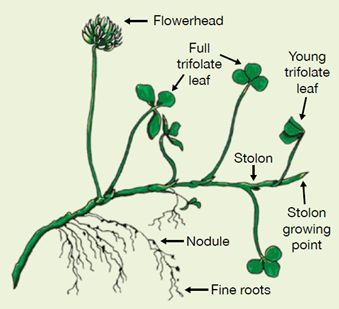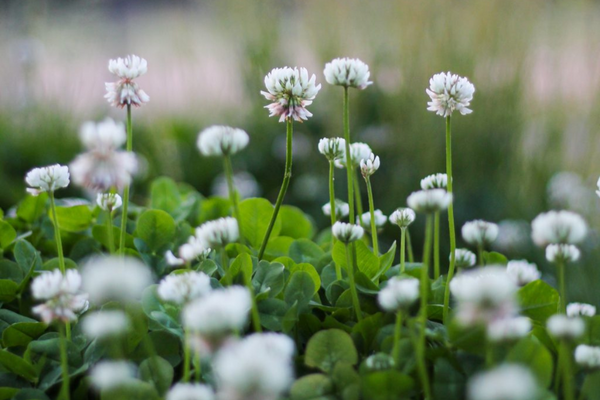Grazing to Promote White Clover
22 April 2024It is often said that we should aim for 30% white clover in pasture swards to benefit from clovers N-fixation capabilities (100-150kgN/ha) and high nutritional value to both reduce reliance on N fertilisers/promote yield and improve silage quality and livestock performance.
In a list of practices to increase sward clover composition (including Mod P status, pH 6-6.5, reseeding and over seeding, leaf size selection, seed mix, avoid high N applications) ‘appropriate grazing to promote white clover’ is often stated but without much detail. That will be the focus of this article.
Growth Habits of White Clover
Understanding a plants growth habit is key to effective grazing management. Shown below, white clover has a multi-branched creeping stem called a stolon from which it grows new leaves, roots (containing the N fixation nodules) and flowers. The stolon stores carbohydrates and proteins giving the plant the ability to over-winter and grow back in the spring.
It is the stolons and having a growth habitat low to the ground that makes white clover grazing tolerant and much more so than prostate legumes, eg red clover, which also means they require different grazing management.
White clover growing points (infographic credit: AHDB)

The yield, and competitiveness, of a given species within a sward is driven by its ability to access light for photosynthesis to grow and compete with other species in the sward. This is why it’s important to understand growth habit as white clover being low to the ground means it can easily be shaded out by grass with high covers reducing light levels to the base of the sward. As such grazing management has a significant impact on white clover with effective grazing to target entry and residual or set stock heights essential to avoid clover becoming out competed by grass.
It also has a different annual growth pattern, with clover starting to grow when soil temperature is 8ºC, whilst grasses start at around 5ºC meaning grass in essence gets a head start in the spring. This means that early spring grazing is beneficial for clover to keep on top of grass covers and maintain light levels to the clover, when it is most vulnerable, with grazing to tight 4cm residuals recommended.
Grazing management should avoid poaching which can lead to excessive stolon damage as hooves penetrating down through soil can bury and break up stolons. As such for early spring grazing in cattle only system, and in wet springs like 2024, grazing must be carefully managed and may mean on-off grazing through the day or turning out of lightest cattle, e.g. youngstock, first.
Grazing at Different Times of Year
Through spring and summer, target entry heights of 8-10cm (2,500-3,000kgDM/ha) and 4cm (1,650kgDM/ha) residuals to avoid high pasture covers smothering out clovers and bring light to the base of the sward on grazing. Excess paddocks taken out of the rotation to maintain entry heights across the platform should be cut as a light crop of high quality silage (not left to high covers which will shade out clover). In set stock systems aim to maintain covers at 4-6cm.
On final rotations ending in October or November aim to graze hard down to 3-4cm. Again, be flexible to avoid poaching. Graze wetter paddocks earlier and when weather is dry. If sheep grazing through to the end of December, however, don’t graze below 4cm to maintain some cover going into winter to protect stolon’s from frost damage and promote spring pasture growth.
Tight grazing in late autumn is beneficial as it allows light down to the clover stolons at the base of the sward. The light penetrating to the base of the sward directly influencing the survival of stolon’s over the winter and so clover content the following growing season.
In reverse, where clover is becoming over dominant, grazing and cutting at higher pasture covers to shade out clover and strategic N use to stimulate grass to outcompete clovers are effective strategies.
In summary, effective grazing management to maintain light levels and photosynthesis for low growing white clover plants is essential to promoting its composition, yield and N contribution within pasture swards.
Daniel Stout, SAC Sheep and Grassland Specialist, SAC Consulting
Sign up to the FAS newsletter
Receive updates on news, events and publications from Scotland’s Farm Advisory Service


